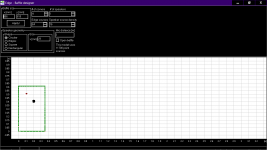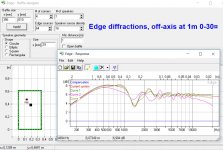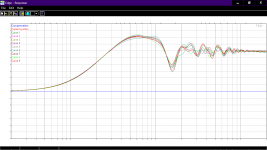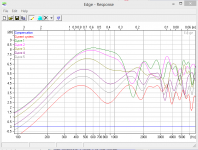Earl has raised a point that seems entirely new and deserves consideration. On the other hand, a natural jazz singer like Diana Krall sounds just dandy on my big ESL dipoles, and I imagine, better than coming out of a point source little box, as Earl suggests.Thank you, that makes some sense to me.
I visit concerts of philharmonic orchestra several times a year and I know what you are speaking about. However, in a recording of a big orchestra, number of microphones, their positioning and mixing makes the resulting sound and imaging and localization in the recorded sound. Imaging from a recording of classical music is usually much better than that you may ever hear in a concert hall
And what PMA says has the ring of mutual experience. Except that orchestra recordings are "cooked" and the localization is almost entirely synthetic in nearly all recordings. Yes, the double-basses show up on the right, but only because they are panned to the right and the recording engineer adds whatever reverb they think helps that track.
Because of the cooking, I think recordings deliver Beethoven's score to the listener more coherently than the concert hall does (for example, the producer will crank up a flute if it is carrying the theme tune). Of course, Mahler's 5th is a whole lot different in a hall (a few days ago) than at home, even if the crucial harp in the "Death in Venice" movement is louder at home.
B
you made the implication that off axis could be EQ corrected in post 242 but it's been edited...
No that's not what I changed.
I don't know what you mean by "consistent", but the directivity will most certainly not be constant. It will beam as the frequency goes up.
Alright here is a screen shot of an edge simulation that shows a baffle and tweeter. Plug it into edge and move the microphone around and you will see the diffraction signature is fairly "consistent". Therefore if the peaks and dips are equalized it will help all around. This is what I've been trying to say, anyways.
Attachments
Last edited:
Of course, Mahler's 5th is a whole lot different in a hall (a few days ago) than at home,
B
... or even 8th 😉
Chalie Laub's post #246 contains your original text and he was also on about correcting your statement sorry for pointing out erroneous statements.
Chalie Laub's post #246 contains your original text and he was also on about correcting your statement sorry for pointing out erroneous statements.
What are you making accusations for, the statements are the same. If you can't understand a basic concept like equalization than find another hobby.
3m distance. I'm genuinely interested if I did something wrong. Looking at your graph I'd say that's more consistent than other positions. Curve 2 is the outlier.
Using your Edge model, I get something like Juhazi. I do not see how peaks and dips line up anywhere. As a result, EQ can not help "fix" the pattern.
I started more or less right on top of the driver. Then I moved off axis keeping the same "height" until I reached 3m to the right. This was at 3m distance. That's only going out to about 45 degrees off axis.
Keep in mind that beveling and rounding, even when pretty large, are only reducing the size of the peaks and dips above 1k-2k Hz.
I started more or less right on top of the driver. Then I moved off axis keeping the same "height" until I reached 3m to the right. This was at 3m distance. That's only going out to about 45 degrees off axis.
Keep in mind that beveling and rounding, even when pretty large, are only reducing the size of the peaks and dips above 1k-2k Hz.
Attachments
Last edited:
Looking at 33's overlays, the consistency of high treble reveals that offset angle was less than 10¤ in every pos. Stereophile uses +/- 15¤ average, but listening window ála Harman means up to 30¤ sideways.
Speaker directivity / off axis response: theory and measurement techniques - Acoustic Frontiers
Speaker directivity / off axis response: theory and measurement techniques - Acoustic Frontiers
Earl has raised a point that seems entirely new and deserves consideration. On the other hand, a natural jazz singer like Diana Krall sounds just dandy on my big ESL dipoles, and I imagine, better than coming out of a point source little box, as Earl suggests.
This is precisely what I am saying. If two characteristics of sound reproduction are at odds - like imaging and spaciousness are - then one must always be clear on which it is that you are looking to get. I've been clear about mine, but very few make their preference of this distinction known.
Using your Edge model, I get something like Juhazi. I do not see how peaks and dips line up anywhere. As a result, EQ can not help "fix" the pattern.
I started more or less right on top of the driver. Then I moved off axis keeping the same "height" until I reached 3m to the right. This was at 3m distance. That's only going out to about 45 degrees off axis.
Keep in mind that beveling and rounding, even when pretty large, are only reducing the size of the peaks and dips above 1k-2k Hz.
You're going quite a bit off axis. I'm keeping the mic closer to the baffle and going in a circle around it. Keep in mind that if the speakers are towed in you will have direct sight.
But one could certainly prioritize for different positions.
IMO getting the 1-3 khz region where the crossover is to be as consistent as possible is the most important priority.
I found how to reproduce 33's plot where the peaks and dips line up. Just increase the mic distance to a very high number (e.g. 9999 meters). Then everything looks the same! Why? Because at that distance the off axis angle you get is all very close to zero, and thus APPEARS the same but that is because it it. You are looking at essentially the same off axis angle (very close to on axis) everywhere. That is unless you zoom out the x axis to match. Then you can again create a non-insignificant off axis angle and the peaks and dips move.
Even if you do not use such a large listening distance, you can get almost the same effect: start with the mix on axis at 3m, move the mic over 1m, and then set the listening distance to 12m).
Is this what led to your plot, 33PolkHigh?
Even if you do not use such a large listening distance, you can get almost the same effect: start with the mix on axis at 3m, move the mic over 1m, and then set the listening distance to 12m).
Is this what led to your plot, 33PolkHigh?
I think it was within 15 degrees listening window. AND no they don't all line up at the axis when you measure in a circle. You can still get swings even when measuring at those angles. You went way off axis to produce a plot that definitely didn't line up.
Obviously the closer one gets to on axis the more priority the measurement has. 3m to right at 3m is quite a bit off axis.
Obviously the closer one gets to on axis the more priority the measurement has. 3m to right at 3m is quite a bit off axis.
Last edited:
You're going quite a bit off axis. I'm keeping the mic closer to the baffle and going in a circle around it. Keep in mind that if the speakers are towed in you will have direct sight.
But one could certainly prioritize for different positions.
IMO getting the 1-3 khz region where the crossover is to be as consistent as possible is the most important priority.
By keeping the mic "close to the baffle" (if I understand you correctly) you are constraining the off axis angle (keeping it low). You should explore angles up to 60 degrees or at least do 45 degrees off axis.
Huh?Obviously the closer one gets to on axis the more priority the measurement has.
Were you not just claiming that you could make on and off responses the same by locating the driver in some particular position on the baffle (in post #248) and then you could just EQ out all the peaks and dips?
I haven't been saying at all that one can have a spherical baffle perfect off axis response it can't happen. What I've been saying is that one can prioritize for consistency.
And its not just making curves line up. Its over a particular frequency range such where the crossover is. And so far what I said has shown to be true. One can make certain angles line up better with other ones.
Are you saying that the different responses at different axes are perfectly random? That's certainly not the case. No you can't have perfect off axis in a box speaker, I already said that.
And its not just making curves line up. Its over a particular frequency range such where the crossover is. And so far what I said has shown to be true. One can make certain angles line up better with other ones.
Are you saying that the different responses at different axes are perfectly random? That's certainly not the case. No you can't have perfect off axis in a box speaker, I already said that.
By keeping the mic "close to the baffle" (if I understand you correctly) you are constraining the off axis angle (keeping it low). You should explore angles up to 60 degrees or at least do 45 degrees off axis.
Yes explore, but the further off axis and the higher in the frequency the less important it is.
Well, that definitely doesn't line up with my line of thinking.
The energy coming from the loudspeaker and going off in those directions, and all the other directions that you have deemed "unimportant" bounce off of the surfaces in the room and come back to the listener. The total sound power returned to the listener by the room is not insignificant, and influences how the loudspeaker "sounds".
This is why what the drivers (alone) and loudspeaker (driver+crossover) are doing OFF AXIS is just as important as on axis.
The energy coming from the loudspeaker and going off in those directions, and all the other directions that you have deemed "unimportant" bounce off of the surfaces in the room and come back to the listener. The total sound power returned to the listener by the room is not insignificant, and influences how the loudspeaker "sounds".
This is why what the drivers (alone) and loudspeaker (driver+crossover) are doing OFF AXIS is just as important as on axis.
- Home
- Loudspeakers
- Multi-Way
- Baffle Diffraction



